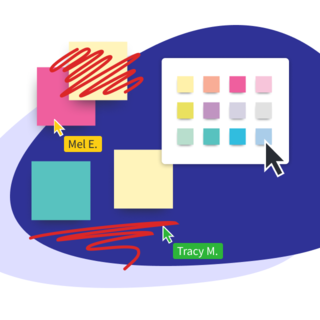It’s thrilling to brainstorm as a team. You get to tap into each other’s energy to inspire new ideas and work through issues and (hopefully) bask in the genius outcomes. But occasionally you’ll need to brainstorm before a group session. You may even find yourself working on an individual project and needing to come up with creative solutions. Suddenly, the only energy is yours, and that can feel scary and intimidating.
Here’s a secret, though: you can come up with incredible ideas on your own using some of the same techniques you’re comfortable using with your team. And the best part? You don’t have to share the break room snacks. Brainstorming on your own is a valuable skill that’s great for generating creative solutions and ideas. And it’s downright enjoyable, too. Here’s how to solo brainstorm.
Benefits of individual brainstorming
Most successful artists create their work by being disciplined. Stephen King begins writing at about 8:30 every morning and sits in the same seat with the same papers arranged around him. Egon Schiele completed dozens of pencil sketches before attempting a final draft. Jazz genius Eubie Blake spent his childhood practicing the piano. Most incredible artists understand that creativity is harnessed through rules and disciplined. Put aside the stereotype of the frenetic oil painter or the misanthropic novelist—the vast majority of our most treasured works of art, literature, and music are born of sheer hard work.
That means if you want to come up with truly exceptional ideas, you’ll need to harness them through that magical combination of discipline and effort. Brainstorming is a critical tool for this.
Here are the primary benefits of brainstorming:
- Prevents outside intervention—Working with a team means you may be reluctant to share your ideas or be influenced by others’ ideas. By brainstorming alone, you’ll only be left to contend with your own mind.
- Breaks routine—You’ll notice most of your day is likely done by rote. Brainstorming helps inspire creativity by allowing your brain to think in a new way.
- Inspires focus—When you’re focusing on finding one solution, it’s much easier for your brain to work.

Examples of when you should brainstorm alone
Individual brainstorming has its place. Want to respond to an email quickly? Probably not a good time to brainstorm. Interestingly, moderately complex solutions are best left to the group, but either end of the spectrum is best for an individual: either very simple ideas or very complex ones.
Here are some times when solo brainstorming might be best:
- Coming up with a new company or product idea
- The direction for an ad campaign
- A solution for supply chain issues
- The color palette for a brand
- The look for a photoshoot
- The concept for hardware design
- Preparing for an important presentation with the rest of the team
It’s also worth noting that some people simply brainstorm better alone. Introverts generally feel like group brainstorming is an exercise in torture. That means that, for them, brainstorming alone through a moderately complex solution may yield better results than brainstorming with a group.
Every individual has their own set of conditions that are best for inspiring creativity. And that means, of course, that some people may struggle with brainstorming on their own. But there are ways to make the best out of a situation that may be initially frustrating. Keep reading.
Individual brainstorming techniques
Don’t think of brainstorming as something that needs to involve endless cloud bubbles. Brainstorming can happen in a lot of different ways. Here are a few favorites:
1. Brainstorm on the move—Moving meditation is a fantastic way to inspire creativity and was a favorite technique of Romantic poets and authors. To do this: get outside and begin thinking about the problem as you walk. This kind of automatic moving helps stimulate the creativity receptors in your brain. It’s important to note that walking meditation is ideal because you don’t have to focus much on the exercise itself. Swimming, running, and walking are great times to brainstorm. Ballet dancing and Crossfit are not times to brainstorm.
2. Stop thinking—You read that correctly. Instead of sitting at your desk trying to be creative, go clean the bathroom. Go grocery shopping. Take a nap. Answer some emails. Give your brain some breathing room and it may surprise you what kind of creativity arises.
3. Start writing—Most writers freewrite before they start working on a creative piece. This trains your brain to begin thinking creatively. To freewrite, simply write about anything that comes to you. It could be about circus animals or electrolytes or scented candles. Just write about anything for five minutes, then begin thinking about the solution you wish to find.
4. Use AI—Lucid's Collaborative AI is a great tool to get the wheels in your brain turning, especially when you're stuck. You can use Lucid's AI features to brainstorm a diverse range of ideas, fuel your creativity, and even sort and summarize your ideas. Artificial intelligence can help generate suggestions you might not have otherwise considered and take you to places you never would've gone.
5. Make a mind map—To create a mind map, write the question you wish to find in the center of a piece of paper or use cloud-based software to help you keep your thoughts organized. For instance, if you’re trying to come up with ideas for a photoshoot, your mind map may have “Fall 2022 Photoshoot” in the middle. Then, draw branches off the center prompt and begin writing down ideas in their own bubbles. Keep writing down anything related to each bubble to refine your ideas.

6. Use word association—This is less regulated than a mind map, but still counts as brainstorming. At the top of your paper, write down the goal or question for which you’re hoping to generate ideas. Below that, write down the first four or five words that come to mind when you think of that solution. From there, jot down the first words you think of when you hear each of those words.

7. Try cubing—Cubing involves looking at an issue or an idea from several different angles. To do this, write down the question or desired solution at the top of a piece of paper. Then write down the following answers to these questions:
- What’s the problem?
- What’s the competition doing?
- What do I think of when I think of this problem?
- What are some possible solutions?
- What are the real-world situations?
- What are the pros and cons?

These answers are essentially generating new ideas and encouraging trains of thoughts to follow.
How to take the results of your solo brainstorming to a group
So you’re a genius, as it turns out. You’ve come up with some stellar ideas through your brainstorming efforts. But now you’ll need to convince your group of your solution. How?
- Make it visual—It’s much easier to present your ideas when they’re written down. Make a presentation showcasing your ideas so your group better understands your solution.
- Use AI to summarize—Lucid's Collaborative AI easily summarizes your brainstorming session for you, so you can present a high-level overview of your thoughts.
- Predict objections—It’s likely your group will spot holes in your idea. Head off those objections by presenting solutions to likely objections.
- Come up with three suggestions—If you only have one idea, then just present the one. But it’s best to have three suggestions and present the strongest suggestion first.
Contending with your own mind can sometimes be an exercise in frustration, but it can also be an incredible opportunity to become more acquainted with your own brilliance. You might be surprised at how much you enjoy being creative when you have a few parameters to give you encouragement. Try brainstorming, and we guarantee you’ll be delighted at the solutions you already have locked inside your brain.

Ignite your own creativity and watch the ideas flow when you try brainstorming solo in Lucidspark.
Get started todayAbout Lucidspark
Lucidspark, a cloud-based virtual whiteboard, is a core component of Lucid Software's Visual Collaboration Suite. This cutting-edge digital canvas brings teams together to brainstorm, collaborate, and consolidate collective thinking into actionable next steps—all in real time. Lucid is proud to serve top businesses around the world, including customers such as Google, GE, and NBC Universal, and 99% of the Fortune 500. Lucid partners with industry leaders, including Google, Atlassian, and Microsoft. Since its founding, Lucid has received numerous awards for its products, business, and workplace culture. For more information, visit lucidspark.com.

